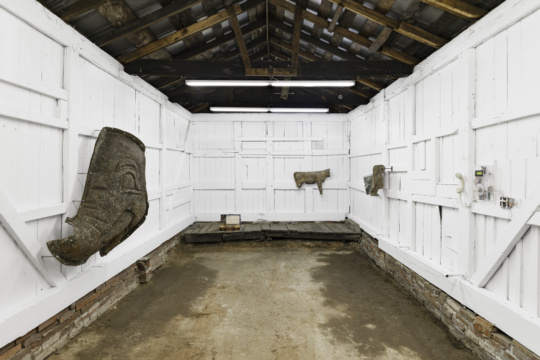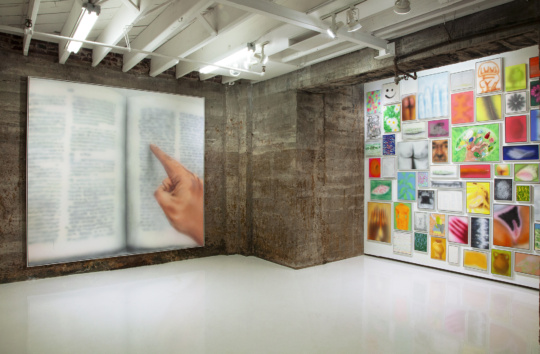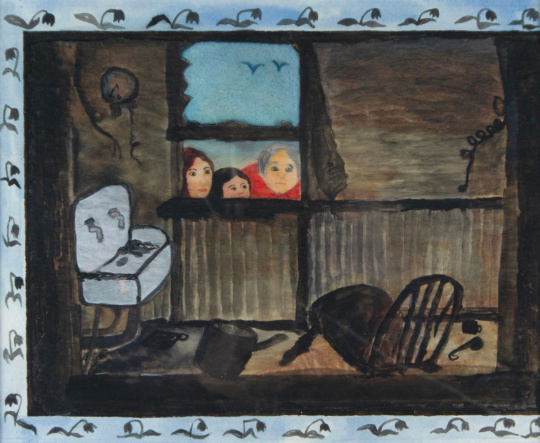
Mildred Thompson was a black American painter, sculptor, photographer, musician, journalist, editor … the list continues. Universality was a theme in her choice of mediums as well as her message. Even after notable success, including a residency at the MacDowell Colony and acquisitions by the Museum of Modern Art, Thompson fled the racial turmoil and gender discrimination of the States to live and work in Europe throughout the 1960s and ’70s. She spent the last decades of her life (1986-2003) in Atlanta, as a professor at Spelman, Morris Brown, Agnes Scott, and the Atlanta College of Art, as well as working as an associate editor at Art Papers. The legacy of her teaching and artwork lives on in Atlanta. So “Mildred Thompson: Resonance, Selected Works from the 1990s,” at the SCAD Museum of Art in Savannah, is an overdue look at one of Atlanta’s own, not far from home.
When walking into the exhibition — curated by Melissa Messina, curator of the Mildred Thompson Legacy Project and the newly appointed curator of Flux Projects — viewers first encounter a sizable space with four surrounding walls. On each of those walls is one large oil painting from Thompson’s Music of the Spheres series from 1996—abstract renderings of the planets Mars, Venus, Jupiter and Mercury. Even though the paintings look nothing like NASA’s awe-inspiring images of cosmic bodies, they are cosmic, or vast, in their interpretations of the universe and its workings. As I stood in the center of that quartet, the paintings, with their bright colors and bursting shapes, began to feel like orbiting bodies, as if some sort of gravity connected me with them and them with each other.

Perhaps that’s why the word “resonance” is so apt in the title of the exhibition. All the works in the show, which vary from paintings to prints to pastels, vibrate off each other. A grand echo of creation, dissolution, uncertainty and wonder reverberates in the art. The work recalls the spirituality and musicality of the later works of Russian painter Wassily Kandinsky, with the interplay between vibrant color and expressive yet decisive circles and lines; Kandinsky once wrote, “The circle is the synthesis of the greatest oppositions. It combines the concentric and the eccentric in a single form and in equilibrium. Of the three primary forms, it points most clearly to the fourth dimension.”
Thompson’s study of science influenced her art-making, as is evident in works like Magnetic Fields, a diptych grounded by a stunning yellow disrupted by deliberate yet expressive red strokes, or Hysteries III, with the constant change of its staccato oil pastel marks and its title’s possible portmanteau of “mysteries” and the physical concept of “hysteresis,” which is defined as “a retardation of an effect when the forces acting upon a body are changed,” particularly in relation to magnetism. Considering Thompson’s move to Germany to escape discrimination, the title could reference her struggle to process the history and status of black Americans despite the forces of oppression and racism.

Although her works don’t overtly address the sexism and racism she faced in the U.S., they do reflect her fascination with the complexity of human existence and the universe and her attempt to decipher the world In the serigraph Advancing Impulses 36, Thompson implies depth through repetition and motion. Small, horseshoe-like shapes explode from one side of a mass of concentric almost-circles. On the other side, the horseshoe shapes spill out of the central mass, stretched to become a wave of elongated parentheses. A whirl of colorful marks fills the background for this scene of actions and consequences, of birth and death, of growth and decay. Separately, the shapes are meaningless; together, they form an image of transformation that can be felt, even if not understood.

37¾ by 25½ inches.
In Thompson’s art, I can feel the presence of forms, even when they’re not fully described. In this way, the artist’s own musings on the nature of the universe and our knowledge of it appear in the work. In the bottom left corner of the 12-by-8-foot Music of the Spheres: Mercury, a spherical shape, possibly the planet itself, materializes in the space between curved red lines. But in the painting, there are many circles in formation. Could they depict Mercury rotating on its axis? Traveling in orbit? Or are they other planets? The work is full of matter, even when I have to fill in the blanks. Take the Muliebris Series—delicate, precise etchings whose darkness and economy of space recalls Thompson’s earlier Five Mysteries Series but with more stillness and room for contemplation.
Even though the works in “Resonance” are just a fragment of her decades-spanning oeuvre, they show the breadth of her technical skill and philosophical expression. Thompson moved in the abstract in artistic practice and in thought, and her interpretations of the world are worth seeing—well, experiencing, because as her work suggests, what one sees and knows is always in motion.
“Mildred Thompson: Resonance, Selected Works from the 1990s” is on view at the SCAD Museum of Art through October 2.
Yves Jeffcoat is an Atlanta-based writer and was a participant in the inaugural cycle of BURNAWAY’s Emerging Art Writers Mentorship Program.




